

www.farmboyzimsflightsims.com
FBZFS
FBZ's Fast Flight's
Panama Canal
MPHO (Howard AFB)
to
MPEJ (Enrique Adolfo Jimenez Air Port)
Panama Canal
MPHO (Howard AFB)
to
MPEJ (Enrique Adolfo Jimenez Air Port)
The Panama Canal is a major ship canal that traverses the isthmus of Panama in Central America , connecting the Atlantic and Pacific Oceans. The construction of the canal was one of the largest and most difficult engineering projects ever undertaken. It has had an enormous impact on shipping, as ships no longer have to travel the long and treacherous route via the Drake Passage and Cape Horn at the southernmost tip of South America. A ship sailing from New York to San Francisco via the canal travels 9,500 kilometres (6,000 mi ), well under half the distance of the previous 22,500 kilometre (14,000 mi) route around Cape Horn.
Although the concept of a canal in Panama dates back to the early 16th century, the first attempt to construct a canal began in 1880 under French leadership. After this attempt collapsed, the work was finally completed by the United States, and the canal opened in 1914. The building of the 77 kilometre (48 mi ) canal was plagued by problems, including disease (particularly malaria and yellow fever) and massive landslides. As many as 27,500 workers are estimated to have died during construction of the canal.
Since opening, the canal has been enormously successful, and continues to be a key conduit for international shipping. Each year the canal accommodates the passage of over 14,000 ships, carrying over 203 million tonnes of cargo. By 2002 about 800,000 ships had passed through the canal.
Although the concept of a canal in Panama dates back to the early 16th century, the first attempt to construct a canal began in 1880 under French leadership. After this attempt collapsed, the work was finally completed by the United States, and the canal opened in 1914. The building of the 77 kilometre (48 mi ) canal was plagued by problems, including disease (particularly malaria and yellow fever) and massive landslides. As many as 27,500 workers are estimated to have died during construction of the canal.
Since opening, the canal has been enormously successful, and continues to be a key conduit for international shipping. Each year the canal accommodates the passage of over 14,000 ships, carrying over 203 million tonnes of cargo. By 2002 about 800,000 ships had passed through the canal.
The most visually impressive feature of the canal is its locks. The lock chambers are 33.53 metres (110 ft) wide with a usable length of 304.8 metres (1000 ft). The available water depth in the lock chambers varies, but the least depth of 12.55 metres (41.2 ft) is at the south sill of the Pedro Miguel locks. These dimensions determine the maximum size of ships which can use the canal; this size is known as. All of the locks on the canal are paired; there are two parallel flights of locks at each of the three lock sites, which in principle allows ships to pass in opposite directions simultaneously. However, large ships cannot cross safely at speed in the Gaillard Cut; in practice ship traffic flows alternately, using both "lanes" of the locks in one direction at a time.
Each lock chamber requires 101,000 of water (26.7 million U.S. gallons) to fill; this water enters the chamber by gravity via a network of culverts beneath each lock chamber. Ships are hauled through the locks by small railway engines called mulas (mules ), named after the animals traditionally used to pull barges), running on tracks on the lock walls; smaller vessels, such as small tour boats and private yachts, are taken as handline transits where mooring lines to the lock walls are handled manually by line handlers on the vessel.
Each lock chamber requires 101,000 of water (26.7 million U.S. gallons) to fill; this water enters the chamber by gravity via a network of culverts beneath each lock chamber. Ships are hauled through the locks by small railway engines called mulas (mules ), named after the animals traditionally used to pull barges), running on tracks on the lock walls; smaller vessels, such as small tour boats and private yachts, are taken as handline transits where mooring lines to the lock walls are handled manually by line handlers on the vessel.
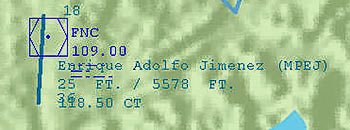
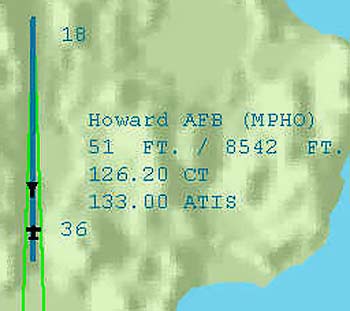
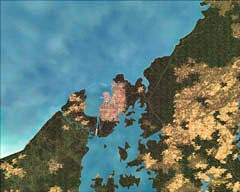
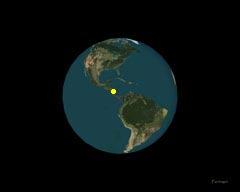
The Panama Canal connects the Gulf of Panama in the Pacific Ocean with the Caribbean Sea and the Atlantic. Because of the S-shape of the Isthmus of Panama, the canal runs from south-east at the Pacific end to north-west at the Atlantic; to avoid confusion, the canal authorities classify transits of the canal as northbound (Pacific to Atlantic) and southbound (Atlantic to Pacific).
The canal can accommodate vessels from small private yachts up to fairly large commercial ships. The maximum size of vessel which can use the canal is known as; an increasing number of modern ships exceed this limit, and are known as post-Panamax vessels. A typical passage through the canal by a cargo ship takes around nine hours. 14,011 vessels passed through the canal in 2005, with a total capacity of 278.8 million tons, making an average of almost 40 vessels per day.
The canal can accommodate vessels from small private yachts up to fairly large commercial ships. The maximum size of vessel which can use the canal is known as; an increasing number of modern ships exceed this limit, and are known as post-Panamax vessels. A typical passage through the canal by a cargo ship takes around nine hours. 14,011 vessels passed through the canal in 2005, with a total capacity of 278.8 million tons, making an average of almost 40 vessels per day.
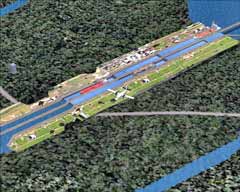
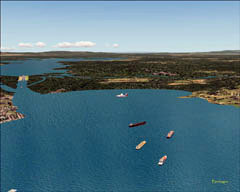
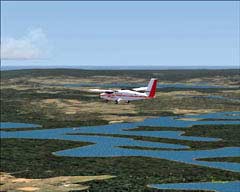
The Future
With demand rising, the canal is positioned to be a significant feature of world shipping for the foreseeable future. However, changes in shipping patterns ó particularly the increasing numbers of post-Panamax ships ó may necessitate changes to the canal. Plans have been floated for a major expansion of the canal; a reincarnation of the 1939, or something like it, has been proposed, to allow for a greater number of transits, and the ability to handle larger ships. The current proposals are for a set of locks capable of handling ships of up to 150,000 tons, over twice the Panamax limit. This would need to be coupled with widening of the Gaillard Cut to handle the larger ships, which would be a major engineering effort.
Any such scheme is likely to be hampered by cost, as well as water supply issues (see above). Current proposals are to address the water issue by expanding the reservoir capacity; however, this has led to concerns over environmental damage to the watershed area. An alternative proposal is to use water recycling, in which fresh water discharging from the lock chambers is pumped back up into the lake to limit water wastage.
With demand rising, the canal is positioned to be a significant feature of world shipping for the foreseeable future. However, changes in shipping patterns ó particularly the increasing numbers of post-Panamax ships ó may necessitate changes to the canal. Plans have been floated for a major expansion of the canal; a reincarnation of the 1939, or something like it, has been proposed, to allow for a greater number of transits, and the ability to handle larger ships. The current proposals are for a set of locks capable of handling ships of up to 150,000 tons, over twice the Panamax limit. This would need to be coupled with widening of the Gaillard Cut to handle the larger ships, which would be a major engineering effort.
Any such scheme is likely to be hampered by cost, as well as water supply issues (see above). Current proposals are to address the water issue by expanding the reservoir capacity; however, this has led to concerns over environmental damage to the watershed area. An alternative proposal is to use water recycling, in which fresh water discharging from the lock chambers is pumped back up into the lake to limit water wastage.
Wikipedia.org is used as a reference for a lot of my articles, and is a wonderfully handy site to bookmark for your own use if you're as curious about places and things as I am! Knowledge is Power!
Here's a link to the information page on the Panama Canal, if you are wanting a bit more information on the area:
en.wikipedia.org/wiki/Panama_Canal
Here's a link to the information page on the Panama Canal, if you are wanting a bit more information on the area:
en.wikipedia.org/wiki/Panama_Canal
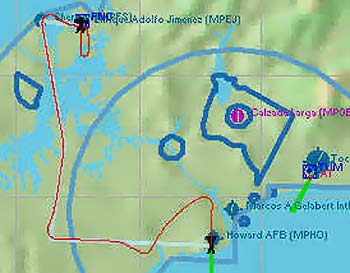
This was a fun flight that I originally planned as a direct flight, but realized that 14 minutes, give or take, was just too fast of a FBZ Fast Flight! So I made the route a bit longer, to see what there was to see! Panama is a beautiful country, lush, tropical, hot... lots of 'skeeters (mosquito's to non-outdoorsy types)! The Canal area of Panama offers all sorts beautiful landscape to explore, be it in a floatplane or conventional aircraft. A fantastically rich environment for floatplane flying, with loads of fingers and offshoots to explore. Lots of interesting and challenging airfields also await you in the Country of Panama. Hope you enjoy "flying" there as much as I did!

I'm becoming a big DeHavilland fan, so for this flight I used the freeware model of the De Havilland DHC6-300 Wheel ver. Innu Milkun C-FWLG by Jean-Pierre Brisard, Barry Blaisdell, Bob May and Kevin Pardy - Premier Aircraft Design. this one is getting a Farmboyzim Freeware Find Review real soon, and if you download it, you'll see why! there's quite a few of this team's aircraft in the Downloads Library, and with each of their releases, these models just keep getting better! More about it later!
Click To Download
Click To Download










Thanks For The Visit !
There's a scenery addon for the Canal, enhancing the locks, adding ships, and some bridges. I could not find the author's name in the file but there was an email, winfriedorthmann@yahoo.com, just to give him credit! Click To Download
